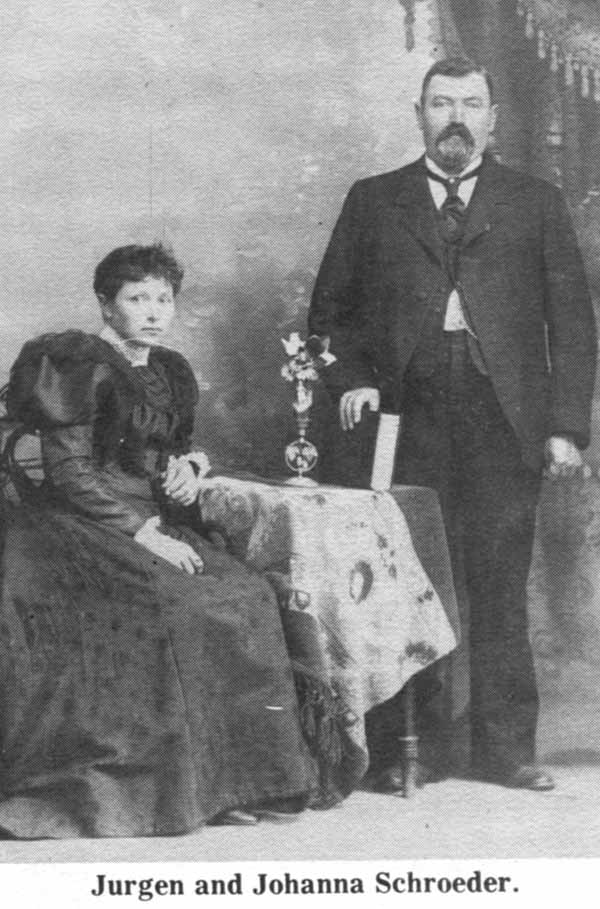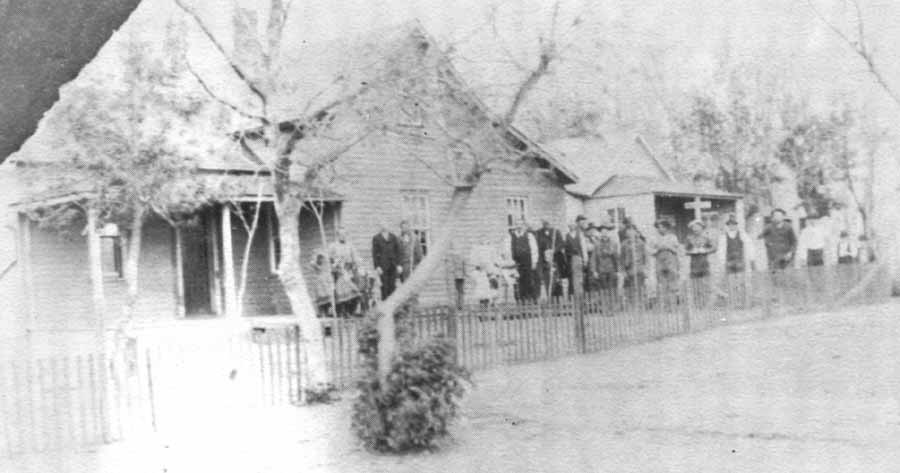Hohenzollern, Morgan Township: 1883-1899
The following is an excerpt from a publication produced for Schleswig's 75th anniversary celebration in 1974. The publication, Schleswig, Iowa: The First 75 Years was edited and compiled by Lillian M. (Kuehl) Jackso and Emma L. (Brasse) Struck.
Many tales were told about Hohenzollern. Eddie Schroeder was born there. Julius Struck and family members could see the place from the parental farm which was just a quarter of a mile south. Others made Hohenzollern a popular village for supplies, repairs and entertainment. The history of Schleswig would not be complete if we did not include some of the early recollections.
The story of Hohenzollern centers around Jurgen Schroeder who emigrated to America in 1868 from Puttgarten on the Isle of Fehmarn, Schleswig-Holstein, Germany at the age of 17. He worked on Iowa Farms in Scott and Tama Counties, and later for his brother near Denison. His first wife, Wilhelmine Carstens of Davenport, died in 1873, leaving four children: Matilda (Mrs. H. Seymour), Willie H., Maggie (Mrs. Herman Jahde) and Herman. His second wife was Johanna Lorenzen of this locality. It was she who was his helpmate the sixteen years they spent at Hohenzollern. Their children are Eddie, residing in Schleswig, Walter of California, Olga (Mrs. W. C. Carnes) and Frieda (Mrs. Will Evers), both of Holstein, Iowa.
Earlier, in 1883, Jurgen Schroeder bought eighty acres of farm land from Jacob Peters in section No. 23 Morgan Township one mile west of our present town of Schleswig. When he arrived here to claim his land he saw the need of the farmers for more easily accessible provisions. Lena Reese recalls the Schroeders built a small grocery store beside their house on the hill. Later they built a larger, two-story one with a stone basement and a one-story saloon to the north "where the chill winds blew." Both house and stores faced the east. The trees to the west formed a background for the "town" but did little to ward off the bitter winter winds.
Supplies for the town
Willie Schroeder with his four-horse team and wagon made trips to Denison at regular intervals for groceries, dry goods and farm items. The Jacob Jensen family, neighbors to the southeast, at times heard the running of the horses and the rumble of the wagon wheels going by in the night when Willie returned with his purchases. He also brought the mail for their customers if there was any. In addition to these chores Willie drove the "Peddlerwagon" through the area on daily routes to provide the housewife with essentials. He continued this business for a while after 1900 from the town of Schleswig.
Town named
Dr. Richard Fuester is credited with naming the village "Hohenzollern" in honor of the Royal House of Prussia, German Royalty since the seventeenth century. The doctor farmed in Grant Township (three miles north where the Walter Ernsts now live) and ministered to the physical needs of the people in times of sickness.
Churches
For spiritual guidance, for marriages and burials, there was the Grant Township Church four miles north. It was the first church in the area and founded in 1870. There were also itinerant pastors that Jurgen Schroeder himself procured and accompanied with his team and buggy on their rounds. One such minister was the Reverend Emil Hansen.
In 1891, Jurgen Schroeder became the official Postmaster at Hohenzollern. He served in that capacity for eight years. The mercantile business increased and the village grew to include a cream and produce station on the creek site below the hill, a blacksmith shop going up along the roadside and a dance hail across from it to the south. A long barn for horses stood further south at the end of the beaten dirt path. There were two streets in "town". One crossed in front of the house and store going from the road to the barn. The other made a path that crossed between the cream station and the blacksmith shop diagonally southwestward, past the dance hall to meet the road going to the barn.
Beer in the well
On the highest part of the hill was a deep, dry well where beverages were kept to cool. Chris Gierstorf tells how at threshing time he was sent by buggy to get the cool ale for the threshers. He was nine years old at the time and lived three miles west and two south. The men from the store fastened a halter around him to a long rope and let him down into the well. Another rope had two tongs which he hooked around the ends of the wooden keg of beer. After the men raised the beer to the surface, they pulled him out. The wooden pony-kegs came equipped with spigots for instant serving.
Dances
Dances were a popular event for the whole family. In summer, for the children, dancing began at 10 a.m. with picnics and games throughout the day. Adult dances were once a month and started in the afternoon on Sundays with a huge dinner served to all by the establishment at 11:00 p.m. Dancing continued into the morning hours. The four or five-piece band played from an elevated alcove in the southwest corner. The Wheeler band from Denison, the musical Christensen family, the Schwartz band and others furnished the music. The bar was along the north wall and Willie Schroeder acted as the official bouncer. Henry Hollander related there were many quarrels, many fights, but all were settled on the spot. There were no court costs; only some aches and pains. At one time there were so many arguments the girls refused to go to any more dances.
Transportation
Transportation was no problem on summer days. Girls walked to Hohenzollern, single boys rode horseback and families had their surreys. After the dance, boys "walked" their best girl home in the moonlight, sauntering over the soft, dusty country road. Their horses trailed on behind. No one minded the dry dust. It was the mud that created real problems like the time one person fell into a mud hole.
School
Hans Iversen recalled walking fourteen miles to the store and back to buy McGuffey Readers and other school books. The McGuffey Readers were used for the first six grades. Upon "graduation" the pupils attended Parochial School and Confirmation Classes at the church. The school of hard work and experience followed. Hans attended Morgan No. 2 while the children from Hohenzollern went to Morgan No. 6 located on the corner east of the village. At one time there were as many as forty pupils enrolled in the small one room school.
Farming and marketing
The population of the community increased and new farms were started. The farmer prospered by raising and feeding livestock. Marketing, however, was a problem since the cattle and hogs had to be driven on foot to the railroad towns of Charter Oak and Ida Grove.
The railroad and Schleswig come
Before long the probability of railroad service to the Hohenzollern area became a topic of discussion. The community's marketing problems seemed to be solved when the Boyer Valley Railroad Company organized in October, 1898 and decided to build a branch line through the area. Ironically, the construction of this line would lead to the complete disappearance of Hohenzollern. However, the coming of the railroad resulted in the new town of Schleswig, Iowa. It began with enthusiasm and has continued in the same vein to this day. The future looks promising. The past is a heritage.
Submitted by Bob Kuehl.




